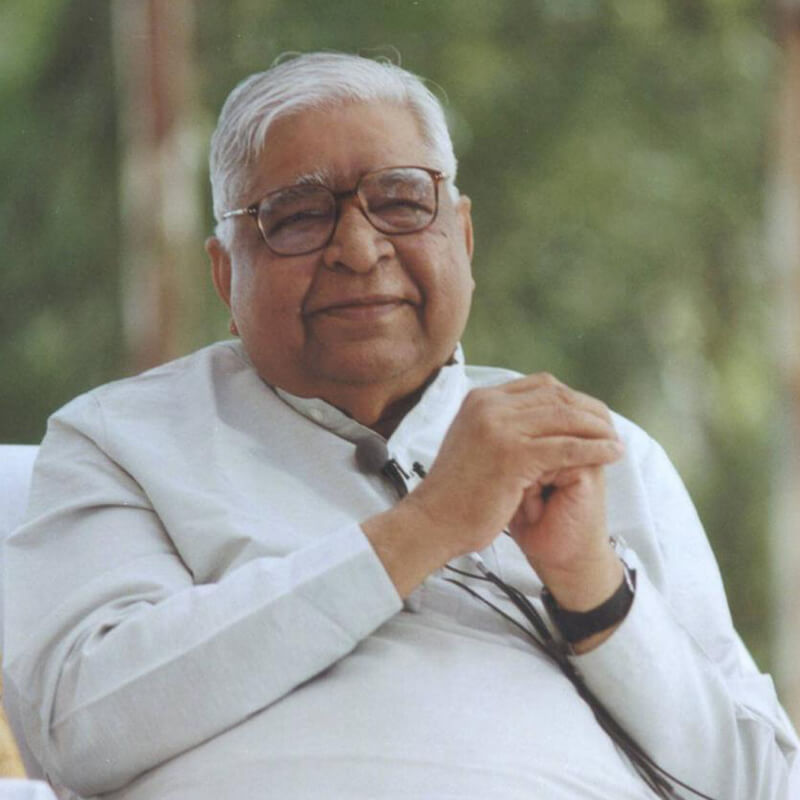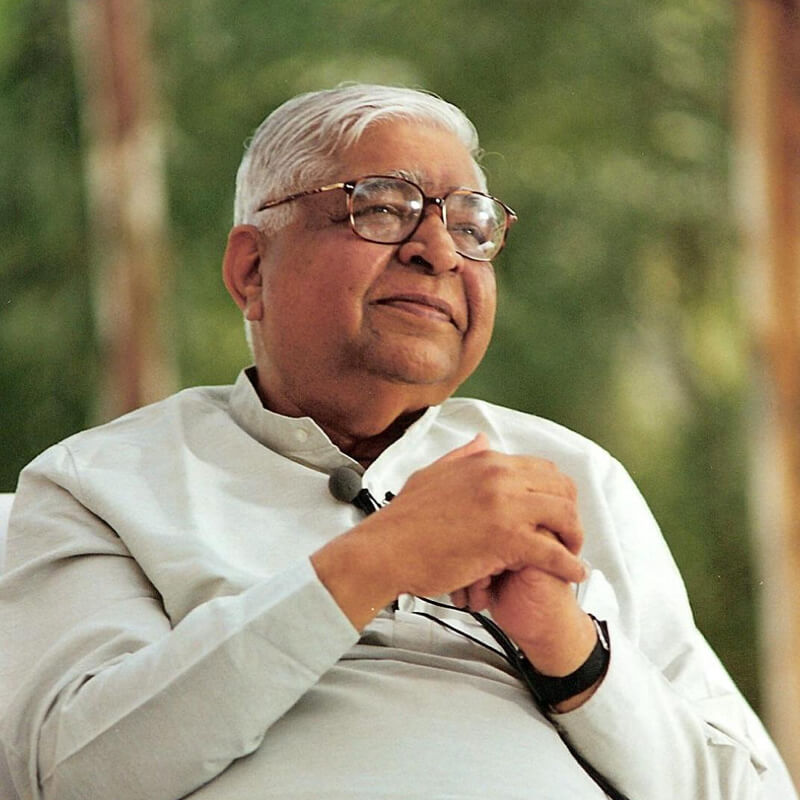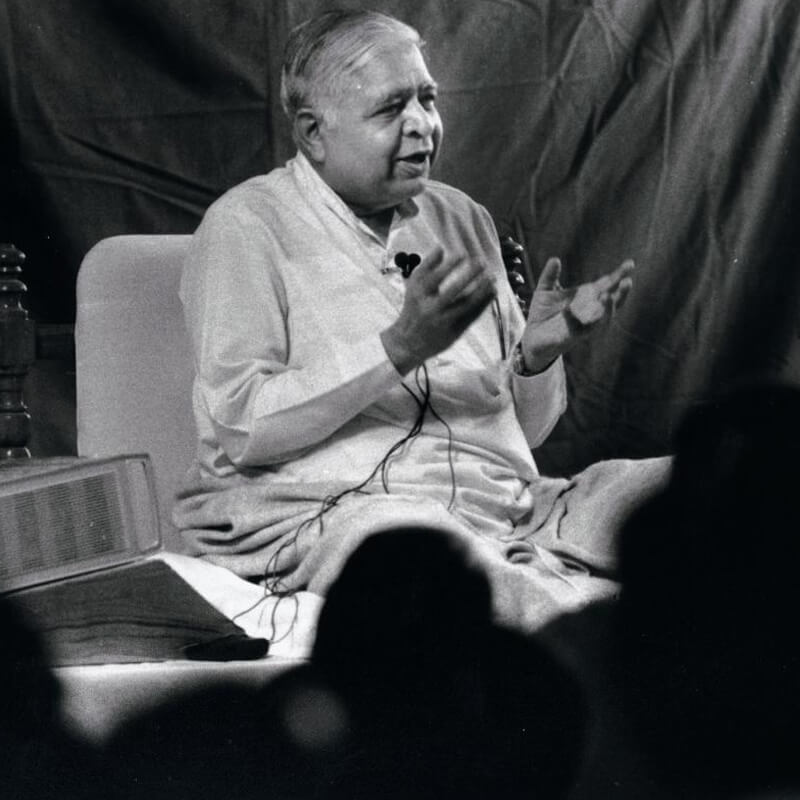(The sacred Buddha relics were enshrined within the main dome of the Global Pagoda on 29 October 2006 in the presence of venerable bhikkhus from many countries, Goenkaji and Mataji, honorable dignitaries, and thousands of Vipassana meditators. The following is an article by Goenkaji on this historic occasion.)
The Path to Peace and Happiness
In multi-religious and multi-cultural societies such as in India, Vipassana is a wonderful, practical path to unity in diversity. Vipassana, an ancient, timeless heritage of India, is the quintessence of all religions: how to live a moral life, to be a master of one’s own mind, to purify the mind. No religion objects to these ideals. No right-thinking person objects to these ideals. Vipassana is the effective, universal method to achieve these ideals.
In past millennia, and in the present day, we are seeing how Vipassana enables one to live a happy, harmonious life. When more individuals achieve inner peace, peace is achieved in homes, in the neighborhood, in villages, towns, cities and countries.
Universal Non-sectarian Path
This unifying process of peace and harmony is visible in Vipassana courses worldwide. During a Vipassana course, people from all religions, castes, nationalities, races and social strata sit together to practice this ancient path. Thousands of Hindus, Muslims, Christians, Sikhs, Jains, Buddhists and Jews have taken Vipassana courses. They follow the same code of discipline and gain benefit from the Vipassana course.
Vipassana courses have been taken not only by the followers of all religions but also by their leaders. Many religious leaders have later told me, “Goenkaji, in the name of Vipassana, you are teaching our religion!” Vipassana courses have been held in temples, mosques, churches, and monasteries.
True Dhamma
In the ancient Pali language, Vipassana means to see things as they are, not as they seem to be. Gotama the Buddha re-discovered this ancient scientific path to real happiness. This is the true Saddhamma, the truth of the laws of nature applicable to all beings in the universe.
The Buddha did not claim any monopoly on this path; neither did he intend to start any sect, cult or ritualistic religion. He told people who came to debate and sometimes to quarrel with him: “Let us keep aside our differences. Let us talk about what we agree upon. I am teaching sīla (morality) samādhi (mastery of the mind) and paññā (purification of the mind).”
The Science of Mind and Matter
The Buddha was a super-scientist who rediscovered certain universal truths using his own body and mind as the laboratory instruments. He discovered that, at the actual level, there is no solidity in the entire universe, that all material phenomena are made up of tiny kalāpas (sub-atomic particles) that arise and pass away with such great rapidity that they give the appearance of solidity. These kalāpas, the basic building blocks of the material universe are nothing but mere vibrations. The Buddha said:
Sabbo ādīpito loko,sabbo loko padhūpito;
sabbo pajjalito loko,sabbo loko pakampito.
-(Therīgāthā 200)
-The entire world is in flames, The entire world is going up in smoke;
The entire world is burning, The entire world is vibrating.
The Role of Bodily Sensations
The Buddha discovered that the key to liberation experiencing the different physical sensations in the body and their nature of arising and passing away (anicca). He also realized that misery arises because of the blind reaction of craving and aversion to these sensations.
One comes out of the habit pattern of misery when one learns to remain equanimous with every sensation, pleasant or unpleasant, with the experiential realization that they are all impermanent, changing every moment. This ability to remain equanimous eradicates old impurities and helps one to change the behavior pattern of the mind.
The Importance of Morality (Sīla)
At the start of the Vipassana course, the student undertakes to observe a moral code of conduct. The student experiences how morality is the essential foundation to inner peace and happiness, not merely an empty, unrealistic ideal. One cannot do any harm to others without first harming oneself – ‘Pubbe hanati attānaṃ; pacchā hanati so pare’.
Anapana
The student in a Vipassana course starts meditation practice with Anapana — observation of the natural incoming and outgoing breath, as it is, without regulating the natural reality of the breath. The student is instructed not to add any shape, color, form, philosophy or image to the breath. As the natural breath is linked directly to the mind, one observes the mind by observing the breath. For instance, when one is angry, the breath becomes hard and irregular; when one is calm and peaceful, the breath becomes soft and subtle.
The truth of the natural breath can be experienced by anyone; this is not the monopoly of any religion or country. Then the student observes the touch of the breath at the point below the nostrils, above the upper lip where the breath touches.
When the student starts observing the point of contact of the breath with the body, he or she begins to experience the truth of sensations on the body: any physical feeling like heat, cold, vibration, tingling, itching, pain, etc.
Vipassana
During the practice of Vipassana, the student is instructed to observe the truth of sensations throughout the body. It is a choice less observation. The student is instructed not to give any importance to any particular sensation or to have any bias or preference for any sensation.
The student proceeds from the gross truths to the subtler truths to ultimately reach the subtlest truth. He observes the mind-matter phenomenon, the truth of the so-called ‘I’, the truth about the causes and effect of suffering and the way out of suffering. He makes this observation within the framework of the body, without any illusion, delusion, imagination or visualization.
The Vipassana student observes the truth of the moment, as it is. So he experiences the truth of the changing reality, from moment to moment, within the framework of the body. Nature is playing its role, one just observes. One realizes how difficult this is! One also realizes how necessary and beneficial this is!
From Reaction to Equanimity
Soon, the Vipassana practitioner experiences how the mind is blindly reacting to these bodily sensations with craving or aversion, with attachment or hatred. He experiences how this habit pattern to the pleasant or unpleasant reality of sensations—which is not in his control—causes a vicious cycle of suffering and misery. Apparently, one seems to be reacting to objects, situations and people in the outside world. In reality, one is constantly reacting to the sensations caused by the outside objects coming in contact with the sense doors of eyes, ears, nose, body, tongue and mind. This deep-rooted habit pattern of blind reaction is the cause of suffering of oneself and others.
By training the mind to objectively observe the sensations, instead of blindly reacting to them, the Vipassana student progresses on the path leading to real happiness. Every time a negative thought or emotion arises, instead of suppressing or blindly expressing these negativities, the student enjoys the benefits of the middle path of mere observation. One realizes that nothing can arise in the mind without a sensation arising on the body. One experiences how the negative habit pattern starts weakening at the root level by dispassionate observation of the sensations. When no new fuel is added to the fire, the fire gradually dies out. One starts experiencing real happiness in life, the happiness of a pure, peaceful mind.
Mettā Bhāvanā (Loving Kindness)
Towards the end of the Vipassana course, the student learns how to share this peace and harmony with all others. When one truly benefits, then one cannot resist sharing the benefits with others. The practice of mettā bhāvanā, an essential part of Vipassana, enables one to share one’s peace, happiness and harmony with all beings. One wishes for the well being of others from the depth of a purified mind. By the practice of mettā, one becomes peaceful and happy and the entire atmosphere around is suffused with peace and harmony.
The Universal Law of Nature
This practical path to real happiness can be called by any name. For conventional, linguistic purposes, it is called Vipassana. Just as the law of gravity works in the same way irrespective of whatever name we give it, the practice of coming out of suffering by objective observation of sensations is beneficial to all, irrespective of whatever it is called.
People from all religions and backgrounds understand this universal truth: one has to have a balanced, pure mind to be happy amidst the vicissitudes of life. They also understand that the saints of the past must have been practicing this technique of developing equanimity to sensations. How else could they generate infinite compassion for the very people who were torturing them to death, as many noble saints of the past from all religions did?
Core of Purity
Every religion has a wholesome essence of love, compassion and goodwill. The outer shells of each religion are different: the various rites, rituals, ceremonies or beliefs. However, all religions give importance to purity of mind. Vipassana helps us to experience this wonderful, happy unity in diversity.
Emperor Asoka: Respect for All Religions
One of the truest followers of the Buddha’s teaching was Emperor Asoka. In one of his rock edicts, he gave us this benevolent message:
“One should not honor only one’s own religion and condemn other religions. Instead one should honor other religions for various reasons. By so doing, one helps one’s own religion to grow and also renders service to the religions of others. In acting otherwise, one digs the grave of one’s own religion, and harms other religions as well. Someone who honors his own religion and condemns other religions, may do so out of devotion to his religion thinking ‘I will glorify my religion,’ but his actions injure his own religion more gravely.”
Let all listen: Concord is good, not quarreling. Let all be willing to listen to the doctrine professed by others.
When this important quality of respecting other religions arises, there will be no sectarian conflicts. One who respects the noble qualities of other religions, instead of finding fault, becomes a true and inspiring representative of his religion.
By practicing tolerance for all religions, Emperor Asoka did not become a weak ruler. There is no record of any communal conflict or foreign invasion during his reign after he renounced violence. On the contrary, his reign was the golden age of Indian history.
Sayagyi U Ba Khin: A Life of Integrity
My Vipassana teacher and Dhamma father, Sayagyi U Ba Khin, is an inspiring example of how Vipassana enables one to live an active, honest, beneficial, and efficient life and to serve others tirelessly and selflessly. He was the first Accountant General of independent Myanmar and a trusted confidant of the Prime Minister of Myanmar. Yet Sayagyi U Ba Khin did not hesitate to point out any impropriety in the government that conflicted with established laws and norms. He took immediate action against any action to bribe him. He often took a strong position against the government. Yet the government kept extending his period of service and postponing his retirement and even changed governmental regulations to allow him to serve longer!
People from all religions came to take Vipassana courses from Sayagyi U Ba Khin, even though he called himself a staunch follower of the Buddha’s teaching. I was a leader of the Hindu community in Myanmar when I approached him to take my first Vipassana course. He told me, “I will not convert you to a Buddhist. I will teach you a technique that will make you a better human being.”
From Bondage to Liberation
I took the Vipassana course and all my doubts and fears were removed. I found that Vipassana is Bhagavad Gita in practice. This is the only conversion that Vipassana does: the conversion from misery to happiness, from ignorance to enlightenment, from bondage to liberation.
As more and more individuals in the world experience this path of converting themselves from misery to happiness, all violence will be eradicated and there will be peace and prosperity all around. This happened during the reign of Emperor Asoka and I have no doubt that it will again happen in the future.
May all beings be happy, be peaceful, be liberated!
Bhavatu sabba maṅgalaṃ — May all beings be happy!





